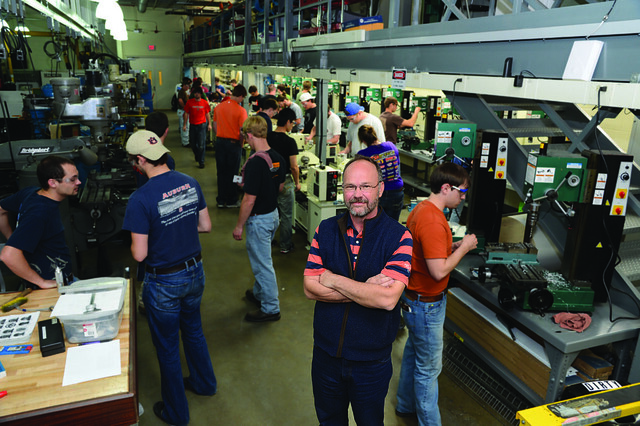It’s tucked into a corner of Wiggins Mechanical Engineering Hall, but it’s far from small. It serves every department in the College of Engineering, and has even seen students from Auburn’s art department. Known to students as the DML, it is more formally named the Design and Manufacturing Laboratory. To faculty member Lewis Payton, who runs the lab, it’s a place where students are given a hands-on feel for basic and advanced machine tool practices.
“Our machine labs have evolved,” notes Payton, who won the college’s William F. Walker Superior Teaching Award this spring. “In the past, they were used as job shops, fabricating parts for departmental projects. The DML is now purely a teaching lab. Our students schedule it for a semester and come out of the experience with a baseline set of skills that allows them to interact with the technicians who will be a part of their career. So while we are not in the business of making tradesmen, we give our students a vocabulary that allows them to move their design projects forward.”
Payton notes that the DML is fully Occupational Safety and Health Administration (OSHA) compliant, not only for the safety of the students, but again, to instruct them in how to recognize and work within the context of a safe laboratory experience when they move into industry. Students who become highly proficient also find themselves in a position to help faculty members build projects, which Payton notes brings both the professor and student closer together. “When we give students this kind of opportunity, they see their instructors less as ‘homework assigners’ and more as education partners. They also start talking to faculty about graduate school . . . and I think that’s a win-win situation.”
The DML lab represents a huge upgrade for the College of Engineering, Payton adds. “We use a model of one machine, one student,” he says. “This makes the lab more representative of a real working environment when you don’t have students stacked up, waiting for their turn on equipment. It is also more conducive to an atmosphere of high precision and accuracy, with our tooling benchmark in the DML at a minimum of five thousandths of an inch.” The lab still has room to improve, he explains, pointing to the need for electric buses to power some of the larger pieces of equipment. “That’s one of the upgrades that will come in time, and will move us to an even higher level.”
[miniflickr photoset_id=72157633504607368&sortby=date-posted-asc&per_page=14]
